Explore The Beauty Of Mahatma Gandhi Nagar Gruh In 2026
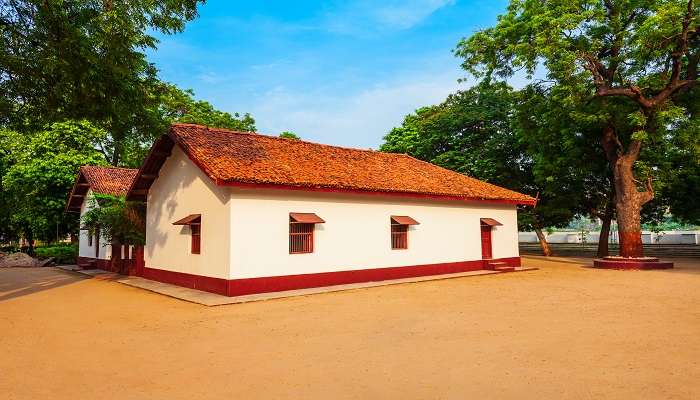
Being the house where the world-renowned leader Mahatma Gandhi, the father of the Indian Nation, once lived, this historic building is a perfect starting point for exploring the life of the man who fought for Indian freedom. Sitting majestically amidst the fast-paced city of Gujarat today, the Mahatma Gandhi Nagar Gruh is more than just accommodation; its rising glory narrates a tale of history and design. Today, the structure of this place is more like a museum where anyone and everyone looking for a slice of history can go and feel the aura of Gandhi, the greatness of his life and the power of his ideologies.
History Of Mahatma Gandhi Nagar Gruh
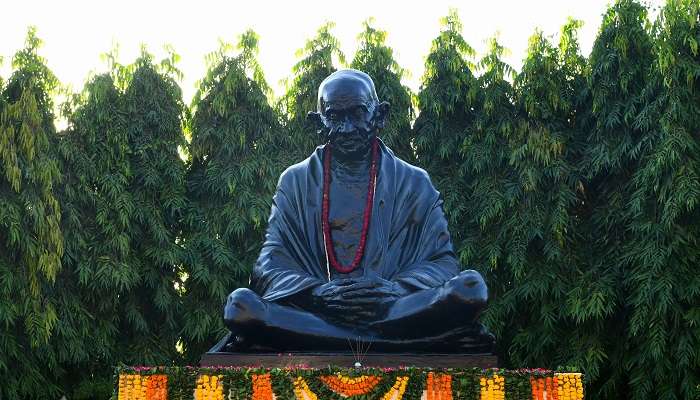
This is the narrative of Mahatma Gandhi Nagar Gruh and is set against the backdrop of India’s liberation struggle. The structure was built in 1921 by Seth Jamnalal Bajaj, a personal friend and a follower of Gandhi. The residence was gifted to him by Bajaj, and Gandhi occupied it till 1948, when he was assassinated. It is here where Gandhi presided over important meetings, planned other liberation struggles, and embraced a spartan lifestyle that inspired millions.
Must Read: Places Near Vadodara
Architecture Of The Gruh
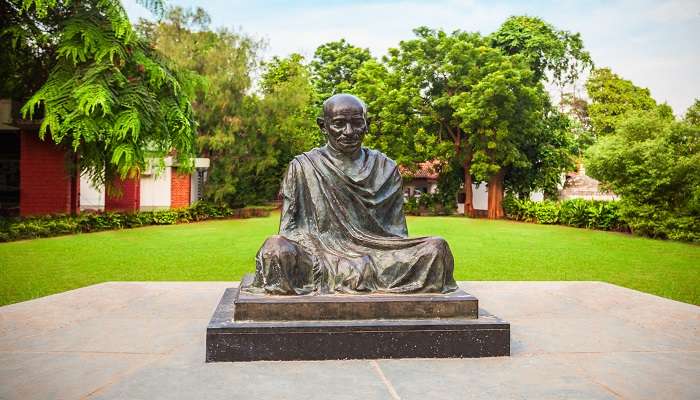
These are some of the best architectural designs, a mixture of Indian and Western designs, as seen in Mahatma Gandhi Nagar Gruh. Here’s a closer look at the key elements that define its character:
Influences of Indian Architecture: This construction technique of red sandstone external wall is one of the indicators of Mughal architecture and gives the monument a majestic and historical look. Jali’s work, an artistic treatment that comprises an ornamental elaboration of blind and screen partitions with motifs formed by interlaced layers of wood, has a double functionality in the project.
Western Influences: The symmetry in the plan and utilization of large openings are also characteristic of the European architectural traditions of the Arts and Crafts movement, which followed the principle of rationality in building construction.
Sustainability Principles: Compared to other brands, it did not pose as a status symbol – thus reflecting Gandhi’s beliefs in the virtues of austere lifestyles. Some measures ensure that natural ventilation and lights are mainly used instead of artificial ones. Red sandstone is the primary material; local wood stresses the project’s local and environmentally friendly aspect.
Critical Features Of Mahatma Gandhi Nagar Gruh
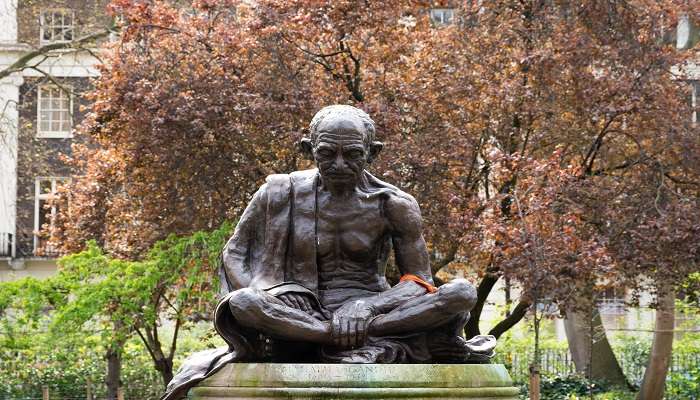
It offers free entry to all visitors, making it an accessible historical and architectural treasure.
There are specific features of Mahatma Gandhi Nagar Gruh that will take you by surprise, such as the following:
Prayer Room: On arrival, the visitor first encounters a calm prayer area. This space represents Gandhi’s profound religiosity and reverence for all religions.
Bedrooms: Visit the simple, spartan beds where Mahatma Gandhi and his wife, Kasturba, slept.
Room: See the spinning wheel, which Gandhi used during the Swadeshi movement to fight to develop their industry and the indigenous handloom industry.
Meeting Room: This space was also used to witness some of the most critical meetings contributing to the fight for India’s independence.
Kitchen and Dining Area: Thus, the limited display of the simple kitchen and eating space gives the viewer an idea of Gandhi’s simplicity, his life, and his cast.
Library: Understand the library closest to Gandhi if you want to get closer to his ideas and personality. The library contains several books concerning different fields and subjects, reflecting his multiple interests and continuous striving for knowledge throughout the year.
Exhibition Halls: The permanent collection accommodates guest exhibitions on different aspects of Gandhi’s life, his theory of nonviolent civil disobedience – Satyagraha – and the struggle for freedom.
Gardens: Sally steps out of the house and into its beautiful grounds. These green zones allowed Gandhi to be alone and create links with the natural environment.
Suggested Read: Places To Visit In Vadodara
Main Attractions
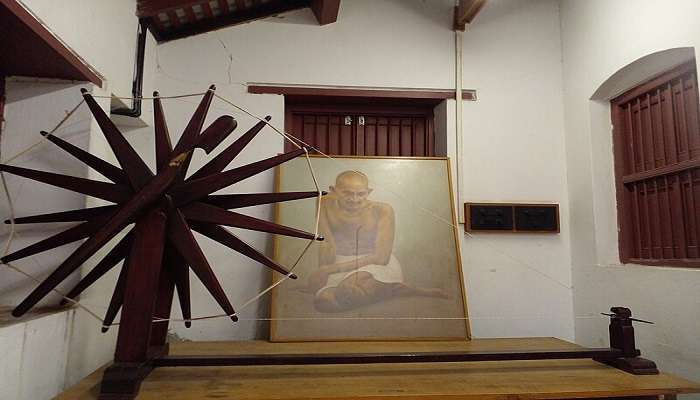
Secretarial Wing: Adjacent to the leading estate, a part of the mansion is not so famous – the secretarial wing. Here, the associates did not rest and continue to work towards completing the mission that Gandhi intended. This area allows you to get a glimpse of the dedicated network that propelled the freedom movement.
Upstairs Exhibit: Behind a very steep set of stairs, there is another room where the terrace that Gandhi used to address people and hold meetings is recreated. Think of the optimism and passion that this environment must have carried when Gandhi used this space to fight for India’s independence.
Charkha Workshop: On the side of Mahatma Gandhi Nagar Gruh, there is a small cottage where the charkhas, or spinning wheels of the no-chlorine movement envisioned by Gandhi, were once situated. Although visitors can’t tour the workshop, the building represents one of the critical principles that Gandhi advocated for—promoting local industries and craftsmanship.
Further Read: Things To Do In Vadodara
Mahatma Gandhi Nagar Gruh is not a museum in the traditional sense; it goes beyond conventional expectations. It is a true story of how ordinary people prevailed through simplicity, turning to non-violent ways and the desire for liberty. For the current contact details, visit the official website of this place to check for changes in the timings and other forthcoming festivals. So, plan your trip to Gujarat for a great vacation.
For our editorial codes of conduct and copyright disclaimer, please click here.
Cover Image Source: Shutterstock
Frequently Asked Questions About Mahatma Gandhi Nagar Gruh
What are the opening hours of Mahatma Gandhi Nagar Gruh?
Mahatma Gandhi Nagar Gruh is generally open from 9:30 AM to 5:30 PM and closed on Mondays and national holidays. However, it's advisable to double-check the timings on the official website before your visit, as they may be subject to change.
What items are not allowed inside Mahatma Gandhi Nagar Gruh?
For security reasons, Mahatma Gandhi Nagar Gruh prohibits carrying large bags, knives, firearms, and combustible materials.
Is photography allowed inside Mahatma Gandhi Nagar Gruh?
Photography is permitted within the museum. Still, flash photography inside the house is discouraged. During your exploration, always be respectful of other visitors.
Does Mahatma Gandhi Nagar Gruh offer guided tours?
While Mahatma Gandhi Nagar Gruh doesn't offer formal guided tours, informative brochures and signage are available throughout the museum. Some tour operators might also include it as part of their larger Delhi sightseeing packages.
Is Mahatma Gandhi Nagar Gruh accessible for visitors with disabilities?
Mahatma Gandhi Nagar Gruh partially accommodates visitors with disabilities. There are ramps at the entrance, but some areas within the house might not be easily accessible. If you have specific accessibility requirements, it's advisable to contact Mahatma Gandhi Nagar Gruh in advance.
People Also Read:
Places To Visit In Gujarat Things To Do In Gujarat Winter In Gujarat

As a Travel Content Writer, I live to conquer the world of globetrotting with words. With my unquenchable thirst for storytelling, I believe that my words will inspire you to travel around the world’s breathtaking landscapes. As for me, I am an unapologetic selenophile, who loves to wander around in a starry night!











